In the world of computer communications, the RS232 serial communication protocol has played a crucial role for several decades. This tutorial aims to provide a comprehensive understanding of the basic principles, workings, and applications of the RS232 protocol. So, let’s dive in!
Our other Electronics-related tutorials are:
You may also like reading:
- How to interface Arduino with RS232 communication protocol
- How to interface esp32 with rs485 (Modbus) sensors with example code
- Multiple ESP32 Communication via RS485
- How to interface Arduino with RS485 (Modbus) protocol
- How to interface Modbus RTU (RS485) sensors with Arduino
Introduction
RS232, also known as Recommended Standard 232, is a widely used serial communication protocol that was introduced in the 1960s. It provides guidelines for the interchangeability and compatibility of devices in serial data communication. RS232 has played a crucial role in computer communications and has been widely adopted in various industries.
It has served as a cornerstone in computer communication, enabling reliable information exchange between computers, modems, and peripherals. The standard specifies the electrical voltage levels, signal timing, and connector pin assignments for serial communication. Despite the emergence of newer protocols, RS232 retains its significance in certain applications, thanks to its simplicity and widespread support.
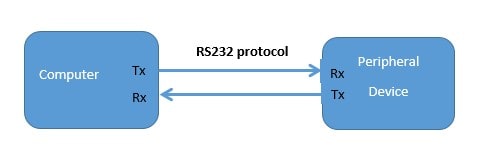
What is Serial Data Communication?
Serial data communication is a method of transferring data between two devices or systems using a single data channel. It involves sending bits of data sequentially, one after the other, over a communication link. The data is transmitted in a continuous stream of bits, with a start bit and stop bit framing each unit of data, typically referred to as a “byte.”
This method is commonly used in various communication protocols, such as RS-232, UART, SPI, and I2C, to transmit data over long distances or between different types of devices. If serial data are synchronized with the clock signal it is called Synchronous serial data communication and if data are not synchronized with the clock signal it is called Asynchronous data communication.

What is the RS232 Protocol?
RS232 is a standard protocol that defines the electrical and functional characteristics of serial communication between devices. It uses a simple point-to-point connection, where data is sent in a sequential manner over a single wire.
RS232 operates on the principle of asynchronous communication, meaning that data is transmitted in individual bits without the need for a continuous clock signal. RS232 is able to communicate up to 15 meters at the rate of 1.492kbps without any interruption between two devices.
RS232 Protocol Applications
RS232, while less prevalent in modern technology, still has several practical applications. Here are some key points regarding its usage:
Industrial Automation: RS232 is commonly employed in industrial automation systems, enabling communication between devices like PLCs, HMIs, sensors, and actuators.
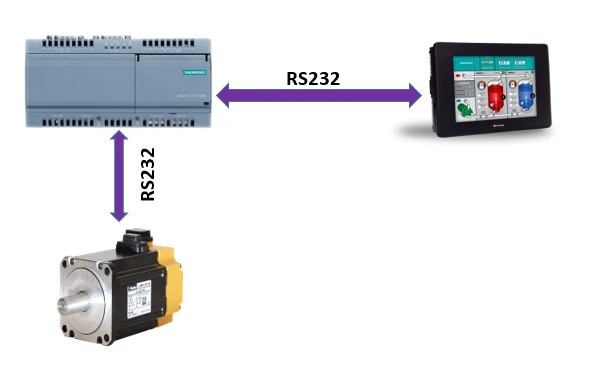
Legacy Systems: Many older systems and devices in various industries rely on RS232 for data exchange and control due to its compatibility and wide adoption.
Point-of-Sale (POS) Systems: RS232 is utilized in POS systems for connecting devices such as barcode scanners, cash registers, and receipt printers, ensuring seamless data transfer.

Telecommunications: RS232 finds use in telecommunications equipment like modems, routers, and switches, allowing configuration and management through a serial connection.

Medical Devices: RS232 is present in medical devices such as patient monitoring systems and diagnostic equipment, facilitating data transmission and control functionalities.
Embedded Systems: RS232 is popular in embedded systems and microcontroller-based projects, providing a simple means of programming and debugging.

How does the RS232 protocol work?
Consider a scenario where you have a computer (DTE – Data Terminal Equipment) connected to a modem (DCE – Data Communication Equipment) using an RS232 cable. The computer wants to send data to the modem for transmission over a telephone line.
The RTS (Ready to Send) signal is used by the Data Terminal Equipment (DTE) device, such as a computer, to inform the Data Communication Equipment (DCE) device, like a modem, that it is ready to transmit data. When the DTE is prepared to send data, it sets the RTS line to a logic high (1) level. The DCE receives this signal and acknowledges it by activating the Clear to Send (CTS) line.
The CTS (Clear to Send) signal is used by the DCE device to indicate that it is ready to receive data from the DTE device. When the DCE is prepared to receive data, it sets the CTS line to a logic high (1) level. The DTE receives this signal and can proceed with transmitting data.
The TXD (Transmit Data) line is used by the DTE to transmit data to the DCE. The DTE sends the binary data bits serially, one bit at a time, over the TXD line. The data is encoded and transmitted following the RS232 voltage levels and protocol.
For example: suppose we want to send 8 bits of information (11001110) to a computer (DTE) to a modem (DEC) then at first we make the RST of DTE to high. At this, DCE clears its CTS and informs DTA that DCE is ready to receive data from DTE. Sending data starts with a star bit that should be 0. After sending start bit data is transmitted by the TX line in this case the data is 11001110. A parity bit is sent after finishing to send data bits and it’s not mandatory to send. One or two bit of stop bit is sent to finish the transmission. Keep in mind that the stop bit should always be 1. Therefore, the total data packet will be 01100111011.

How RS232 protocol processes the data
Voltage Levels
RS232 employs voltage levels to represent binary data. Traditionally, positive voltage represents logic 0 which ranges from +5V to +15V, while negative voltage represents logic 1 in the range of -5V to -15V. Logic 1 is referred to as “marking” and logic 0 is referred to as “spacing”. However, modern RS232 implementations often use inverted logic, where positive voltage represents logic 1, and negative voltage represents logic 0.

Data Encoding
To transmit data effectively, RS232 utilizes a method called data encoding. It converts the binary data into a format suitable for transmission over the serial connection. Commonly used encoding schemes include ASCII (American Standard Code for Information Interchange) and Unicode.
Start and Stop Bits
RS232 adds start and stop bits to each data byte transmitted. These bits provide synchronization and framing for the data. The start bit indicates the beginning of a data byte usually referred to as 0, while the stop bit marks its end. Typically, RS232 uses one start bit and one or two stop bits.
Parity Bit
The parity bit is a basic error-checking mechanism used in data communication. It comes in four variations: even, odd, marked, and spaced. To illustrate, consider the number 011. In the case of even parity, the parity bit would be set to 0, while for odd parity, it would be set to 1.

Baud Rate
The baud rate determines the speed at which data is transmitted over an RS232 connection. It represents the number of signal changes per second. Common baud rates for RS232 communication include 9600, 19200, and 115200 bits per second (bps). Higher baud rates allow for faster data transfer but may require more reliable cabling.
RS232 Cable
An RS232 cable, also known as a serial cable, is used to establish a connection between devices that follow the RS232 serial communication standard. This cable enables the transmission of data and control signals between devices such as computers, modems, printers, and other peripherals.
RS232 Connector Types
RS232 supports different connector types, including DB9 and DB25. The DB9 connector comprises nine pins, while the DB25 connector has 25 pins. These connectors ensure a secure and reliable physical connection between devices.
These cables are of two types one is Male connectors (DTE) and another one is female connectors (DCE). For example, DTE (Data transmission Equipment) cable is used for communicating between PC and modem, and DCE (Data communication Equipment) cable is used for communicating between modem and PLC or microcontroller.
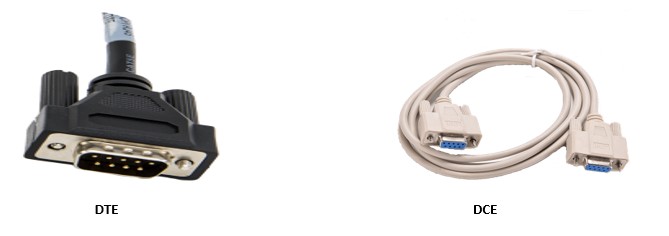
DB-9 Connector
The DB9 connector, also known as a DE-9 connector, is a common type of serial communication port. It features nine pins arranged in a compact rectangular shape. The DB9 connector is widely used for various applications, including connecting peripherals such as mice, keyboards, and printers to computers, as well as for serial communication (RS232) between devices like modems, routers, and industrial equipment. You can buy it from Amazon
DB-9 Connector Connection Diagram

DB-9 Connector Pinout
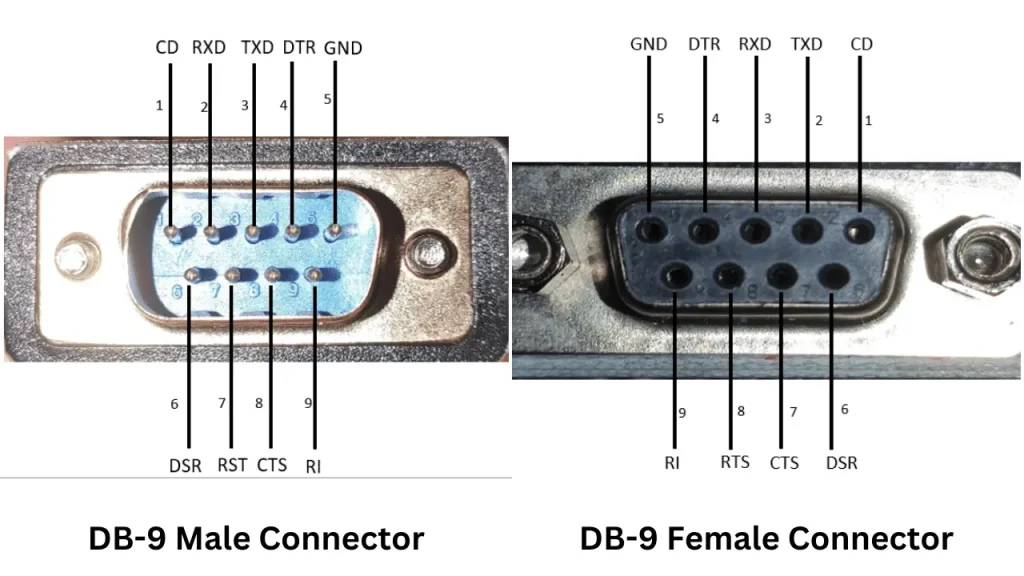
DB-9 connector pin definition
| Pin Number | Description |
|---|---|
| 1 | Carrier Detect (CD) |
| 2 | Receive Data (RXD) |
| 3 | Transmit Data (TXD) |
| 4 | Data Terminal Ready (DTR) |
| 5 | Ground (GND) |
| 6 | Data Set Ready (DSR) |
| 7 | Request to Send (RTS) |
| 8 | Clear to Send (CTS) |
| 9 | Ring Indicator (RI) |
RS232 to USB cable
There are another three types of custom RS232 cables available in the market. The first one is RS232 to USB which helps you to communicate your PC to RS232 devices. This type of cable is also available in Amazon.

RS232 to Ethernet Cable
2nd one is RS232 to Ethernet which also allows you to communicate your PC to RS232 devices. RS232 to Ethernet cable is also available in Amazon.
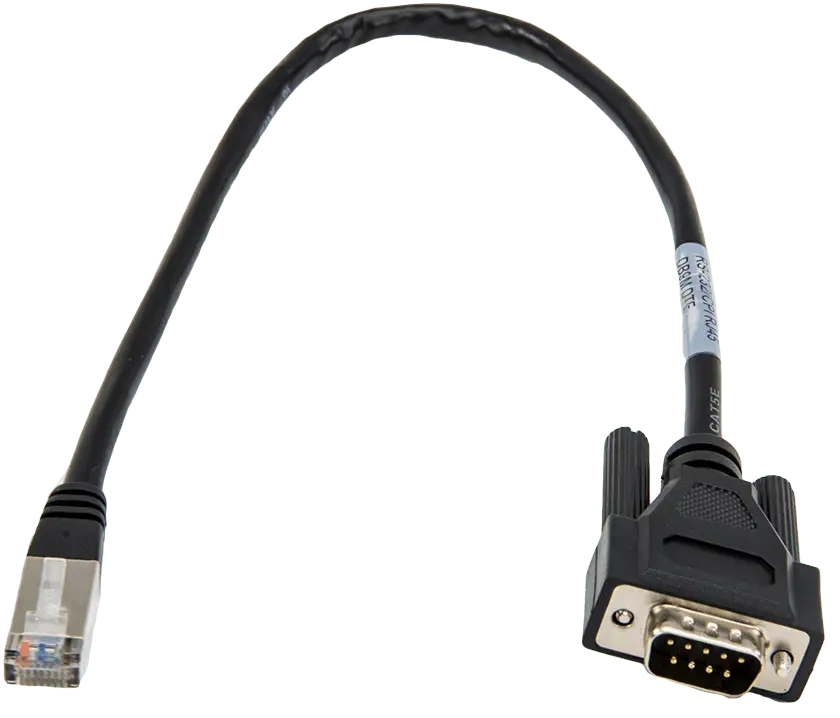
RS232 to UART module
And 3rd one is a module for communicating between the microcontroller and PC using RS232 protocol. This module is DCE (Data Communication Equipment) module and to communicate with PC you need DTE (Data transmission Equipment) for example, DB9.
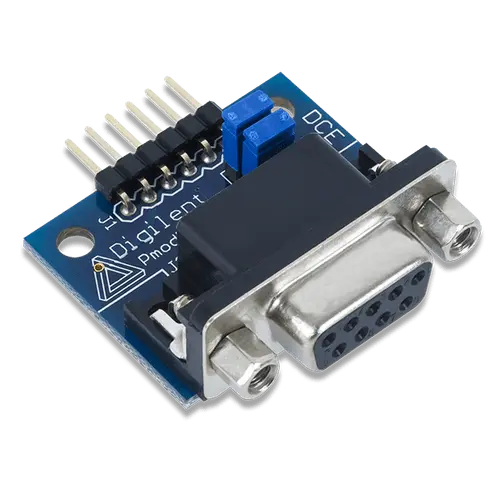
Cable Length Limitations
An important consideration in RS232 communication is the limitations imposed by cable length. Due to voltage drop and signal degradation, RS232 cables are typically limited to a maximum length of 50 feet (15 meters). However, the use of signal amplifiers or converters can extend the reach of RS232 communication.
Limitations of RS232 Protocol
While RS232 has been widely used for serial communication, it also has certain limitations that have led to its declining popularity in recent years. Here are some of the limitations of RS232:
Limited Transmission Distance: RS232 communication is limited in terms of transmission distance. Typically, the maximum reliable distance for RS232 is around 50 feet (15 meters). Beyond this distance, signal degradation can occur, leading to errors in data transmission. This limitation makes RS232 less suitable for long-distance communication requirements.
Lower Data Transfer Rates: RS232 is a relatively slower communication protocol compared to modern alternatives such as USB, Ethernet, or wireless technologies. It is typically limited to lower data transfer rates, typically ranging from 19.2 kbps (kilobits per second) to 115.2 kbps. This limitation can be restrictive for applications that require high-speed data transmission.
Incompatibility with Modern Interfaces: RS232 interfaces are not directly compatible with many modern devices such as smartphones, tablets, and laptops, which often lack RS232 ports. This incompatibility makes it challenging to connect RS232 devices directly to these newer devices without additional adapters or converters.
Bulkiness and Cable Limitations: RS232 cables, especially those with DB9 or DB25 connectors, can be bulky and less flexible compared to modern cable types. The size and limitations of RS232 cables can restrict their use in compact or portable devices where space is a constraint.
Lack of Plug-and-Play Support: RS232 communication typically requires manual configuration and setup of communication parameters such as baud rate, parity, and stop bits. This lack of plug-and-play support can make initial setup and troubleshoot more complex compared to newer communication interfaces that offer automatic detection and configuration.
Despite these limitations, RS232 still finds utility in specific applications, especially in legacy systems, industrial automation, and scenarios where compatibility with existing RS232 devices is crucial. However, for many modern applications, alternative communication protocols with higher data rates, longer transmission distances, and more convenient interfaces have become preferred choices over RS232.
